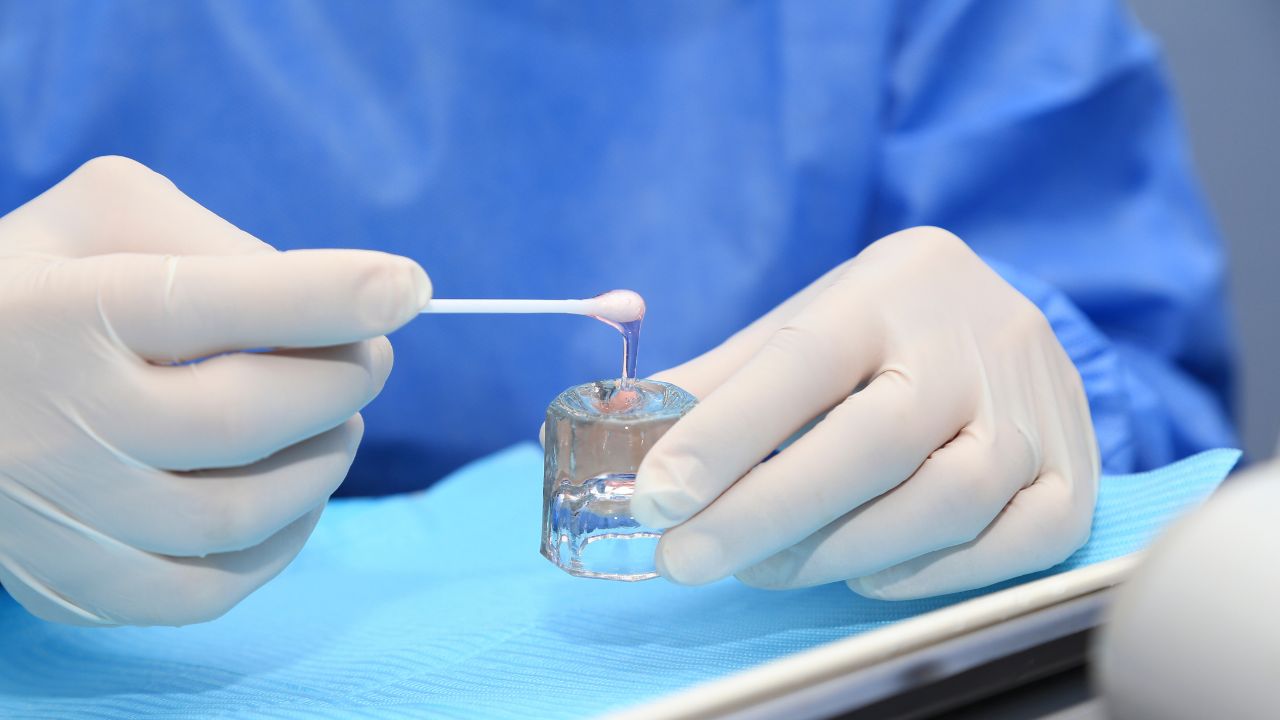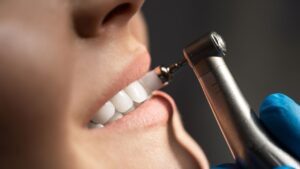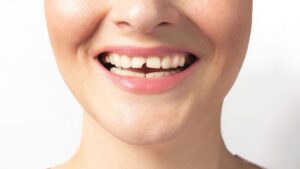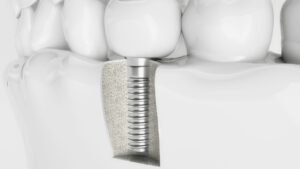Tooth decay, also known as dental caries, is a common issue affecting individuals of all ages in Singapore and across the globe. If left unaddressed, cavities can lead to discomfort, pain, and more complicated dental problems down the line.
For many years, the standard approach to dealing with cavities has been the “drill and fill” method. While effective, this traditional technique can sometimes cause anxiety, particularly for young children or those with dental fears.
Fortunately, dental science continually evolves, and one modern, minimally invasive option gaining traction is Silver Diamine Fluoride (SDF). This treatment offers a often painless and quick way to manage cavities, proving especially beneficial in certain situations and for particular patients.
The introduction of SDF represents a move towards more conservative dental care, focusing on arresting decay with less aggressive interventions, which appeals to those seeking gentler alternatives. Furthermore, its ease of use and potential for lower costs could make effective cavity management more accessible, especially for vulnerable groups within the community.
1. What Is Silver Diamine Fluoride (SDF)?
Silver Diamine Fluoride, or SDF, is a medical-grade, clear liquid that dentists can apply directly to teeth. It’s a simple solution with a powerful impact, composed of a few key ingredients that work together:
- Silver: This component acts as an antimicrobial agent. Think of it as a targeted antibiotic for the tooth, working to kill the specific bacteria that cause cavities.
- Fluoride: A well-known ally in dental health, fluoride helps to rebuild and strengthen tooth enamel through a process called remineralization. This makes the tooth surface more resistant to future decay.
- Ammonia: This ingredient helps to keep the silver and fluoride components stable in the solution, ensuring they can work effectively together.
The solution itself has a high pH, typically between 10 and 12. This characteristic is one reason why dentists take care to protect the gums and surrounding soft tissues during application, often using a protective barrier like petroleum jelly.
2. How Does Silver Diamine Fluoride Work to Fight Cavities?
The effectiveness of SDF lies in its dual-action approach to tackling tooth decay. Once applied to a cavity, the silver and fluoride components get to work:
- The silver ions are the bacteria killers. They target and eliminate the specific microorganisms that are responsible for causing cavities and helping them to progress.
- The fluoride ions work to remineralize the tooth. This means they help to rebuild the tooth structure that has been weakened by decay, making it harder and more resistant to acid attacks from bacteria.
This combined action effectively “arrests” or stops the cavity in its tracks, preventing it from getting bigger or deeper. A noticeable change after SDF treatment is that the affected part of the tooth becomes harder.
This hardening is a key indicator for dentists that the decay process has been successfully halted, and it’s something they will check during follow-up appointments.
It’s important to understand that SDF’s mechanism is fundamentally different from that of a traditional filling. A filling involves the physical removal of the decayed tooth tissue, and then the space is filled with a restorative material.
SDF, on the other hand, treats the decayed tissue directly, altering it chemically to stop the decay process without the need for excavation. This is why it’s considered a minimally invasive treatment—it preserves more of the natural tooth structure.
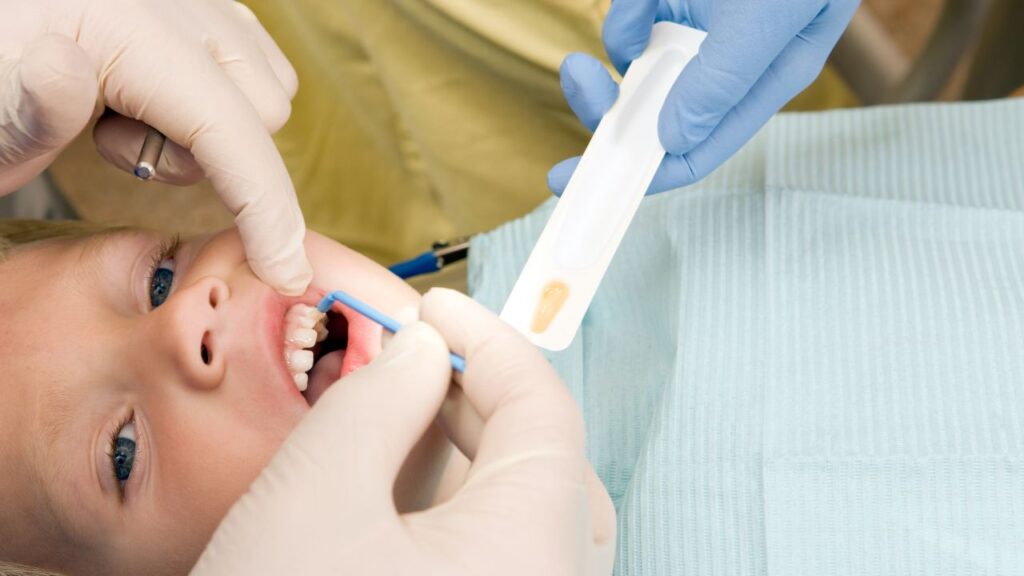
3. Advantages Of Silver Diamine Fluoride (SDF) Treatment
SDF offers a range of benefits that make it an attractive option for managing dental decay in various circumstances:
- Painless and Quick Application: The procedure is generally painless and typically takes only a few minutes per tooth. The liquid is simply brushed onto the cavity.
- No Drilling or Needles: This is perhaps one of the most significant advantages, especially for individuals who are anxious about dental procedures, young children, or those with dental phobias. It’s a truly non-invasive approach.
- Effective in Stopping Cavities: Clinical studies have shown SDF to be highly effective in halting the progression of existing cavities. Some research indicates it can arrest up to 80% of cavities when applied biannually, and it may also help prevent new cavities from forming.
- Buys Time: SDF can postpone or even eliminate the need for fillings, crowns, or more complex treatments. This “buys time,” allowing a child to mature and become more cooperative, or for other dental or medical factors to be addressed. This strategic advantage can reduce the immediate need for treatments requiring sedation or general anesthesia, which can be a significant relief for parents and caregivers.
- Reduces Tooth Sensitivity: Beyond its cavity-fighting properties, SDF is also FDA-approved and effective for reducing tooth hypersensitivity.
- Often More Affordable: Compared to restorative treatments like fillings or crowns, SDF application is generally less expensive.
4. Disadvantages Of Silver Diamine Fluoride (SDF) Treatment
While SDF offers many advantages, it’s crucial to be aware of its potential downsides to make an informed decision:
- The Black Stain: This is the most notable and often primary concern. The decayed portion of the tooth treated with SDF will turn permanently black or dark brown. It’s important to emphasize that healthy tooth enamel will not stain.
For baby teeth, the black stain is temporary in the sense that the tooth will eventually fall out and be replaced by a permanent tooth, which will not be affected. However, for permanent teeth, especially front teeth, the aesthetic impact can be significant. In some cases, the black stain can later be covered with a tooth-colored filling or other restorative material once the decay is arrested and if the patient can tolerate the procedure.
This is a critical trade-off: the non-invasive benefit versus the aesthetic outcome.
- Temporary Staining of Soft Tissues: If SDF accidentally comes into contact with the gums, lips, or skin, it can cause a temporary, harmless brown or grayish stain, sometimes described as being similar to a henna tattoo. This typically fades and disappears within one to three weeks. Dentists take careful precautions to minimize this risk.
- Metallic Taste: Some patients might experience a temporary metallic taste immediately after the application. This usually goes away quickly, often by the next day.
- Minor Gum Irritation: In rare instances, if SDF touches the gums, it might cause mild, temporary irritation or a stinging sensation. This usually resolves within a day or two.
- Not a Complete Fix for Tooth Structure: SDF arrests the decay process, but it does not fill the hole or restore the tooth’s original shape, strength, or function. A filling or crown might still be necessary later on for these purposes.
- Reapplication May Be Needed: SDF is not always a one-time solution. To ensure continued success in arresting decay, follow-up appointments and reapplication of SDF (for example, every 6 to 12 months) are often necessary, especially if the cavity is not subsequently restored with a filling. This implies that SDF is more of a “management” strategy for caries rather than a one-off “cure,” requiring an ongoing commitment.
- Not 100% Effective for All Cavities: While SDF is highly effective, research suggests it may not stop all cavities from progressing. Estimates vary, but some studies indicate that around 20% of treated cavities might not arrest with SDF alone.
- SDF is not suitable for everyone: It should not be used in patients who have a known allergy to silver. It’s also generally avoided if there are open sores, ulcers, or significant inflammation in the mouth, or if the tooth’s nerve (pulp) is involved or infected, as indicated by spontaneous pain or swelling. A proper dental diagnosis by a qualified dentist is essential to determine if SDF is appropriate
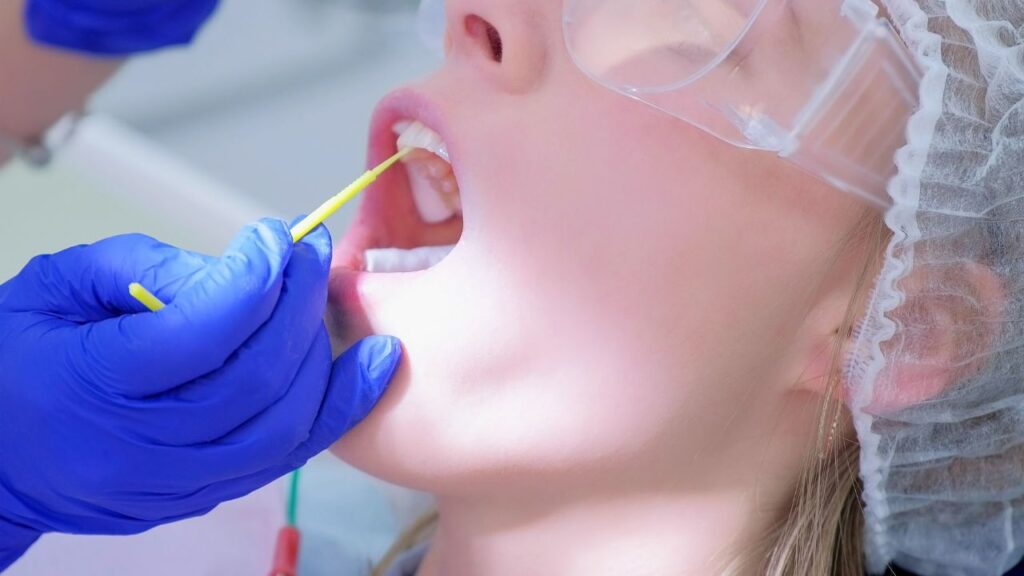
5. Is Silver Diamine Fluoride (SDF) A Good Option for You Or Your Child in Singapore?
SDF can be a particularly good choice for several groups of people in Singapore:
- Children with early-stage cavities or multiple cavities, especially in their baby (primary) teeth.
- Young children who are anxious, fearful, or may have difficulty cooperating for longer, more traditional dental procedures.
- Patients of any age with special healthcare needs or disabilities that make conventional dental treatment challenging to perform.
- Situations where cavities are located in areas that are hard to reach or treat with conventional methods.
- When the goal is to delay more invasive treatments, such as fillings or crowns, until a child is older, more cooperative, or other circumstances are more favorable.
- Elderly patients or individuals who may have difficulty accessing regular or extensive dental care.
- Anyone suffering from tooth hypersensitivity, as SDF can provide relief.
- Patients Who Avoid or Can’t Access Traditional Dental Care: Anyone who has been putting off a filling due to fear, time, or cost might consider asking about SDF. It can serve as an interim measure to stop a cavity from getting worse until you can get a filling.
It is not just for “bad” teeth; SDF can also be considered a proactive measure for “difficult-to-treat” cavities or high-risk tooth surfaces before they develop into more significant problems. This broadens its application from being solely a last-resort treatment to also being a preventive or early-intervention tool in specific contexts.
Ultimately, the decision to use SDF is a personalized one. A qualified dentist in Singapore is the best person to assess whether SDF is a suitable option. They will consider the individual’s specific dental condition, the number and location of cavities (the aesthetic impact on front teeth is a key consideration ), overall health, age, ability to cooperate, and access to ongoing care.
6. Getting Silver Diamine Fluoride (SDF) Treatment In Singapore
SDF treatment is available in Singapore through various dental service providers:
- Public Healthcare Institutions: Specialist dental services, which would include assessments for and application of SDF where appropriate, are available at major public centres like the National Dental Centre Singapore (NDCS) and the National University Centre for Oral Health, Singapore (NUCOHS).
- Private Dental Clinics: Private dental practices across Singapore also offer SDF treatment as part of their services for suitable patients. Not every dental clinic routinely uses SDF, especially if they focus mainly on adult cosmetic dentistry. It’s a good idea to call ahead or look on the clinic’s website to confirm they provide SDF treatment.
- Consider a pediatric or family dentist for young children: If you’re seeking SDF for a child, a pediatric dental clinic or a family dentist known to be good with kids can make a big difference. Pediatric specialists are specifically trained to manage children’s behavior and can skillfully apply SDF while keeping your child comfortable.
6. Conclusion
Silver Diamine Fluoride offers a valuable, minimally invasive, and often cost-effective approach to managing dental cavities in Singapore. It is especially beneficial for certain groups of patients, such as young children, individuals with anxiety or special needs, and in situations where traditional dental treatments might be challenging.
The primary consideration for many is the trade-off between SDF’s effectiveness in stopping tooth decay and the permanent black staining of the treated cavity area. However, its ability to arrest decay without drilling and often without pain makes it a compelling option.

